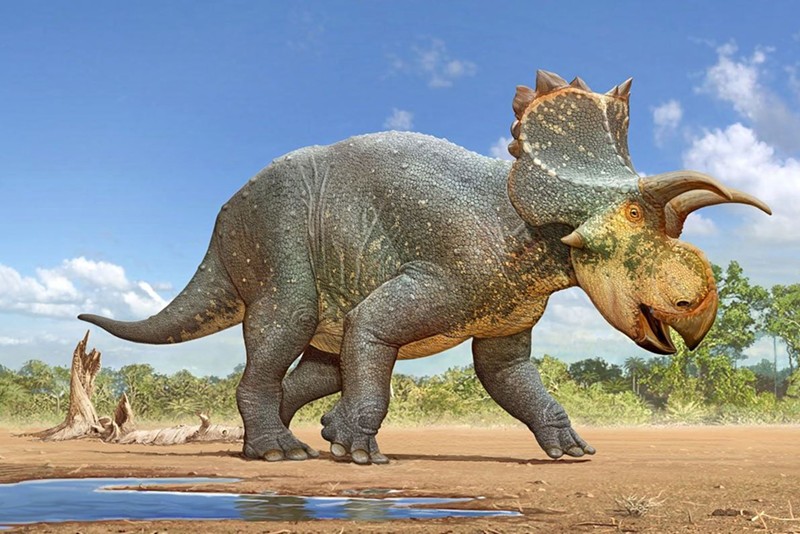The new species, Crittendenceratops krzyzanowskii, is named in a New Mexico Museum of Natural Science and History Bulletin from October 2018, as announced by scientists on Friday.
By trade an interior plantscape designer, Krzyzanowski found part of the creature's skull in the year 2000 while fossil hunting in Adobe Canyon in the Santa Rita mountains. The amateur paleontologist was volunteering his time as part of a dig for ceratops-related bones conducted by the New Mexico museum and teams with the Arizona Sonora Desert Museum. Bits of bone found in the 1990s by these teams (without Krzyzanowski) were later determined to comprise a second individual of the species, according to the scientific paper.
A horned, cow-like plant-eater, Crittendenceratops lived 73 millions years ago in the land now known as southern Arizona. Back then, North America didn't exist. It was Laramidia, an ancient continent of jungles and lakes where the mammalian ancestors of humans scurried between the legs of dinosaurs.

Stan Krzyzanowski died in 2015 at age 77, having contributed significantly to paleontology research in Arizona.
Spencer Lucas, a curator at the New Mexico Museum of Natural History and Science and one of the paper's four authors, said that scientists ultimately determined that this was a significant find — a species that adds to the growing body of knowledge about the variety of ceratops-like creatures and their range. Plus, it's one of the rare few new species of dinosaur that's been found and named in Arizona, he said.
"This is a substantial addition," said Lucas, who had just returned from field work in New Mexico on Friday evening when Phoenix New Times reached him. "I can’t even think of six dinosaurs that have been named from Arizona."
The most famous of those, so far, is likely Sonorasaurus, which Governor Doug Ducey and the State Legislature deemed the official state dinosaur this year.
This is the second time the longtime Tucson resident, who died in 2015 at age 77, has been honored with the name of a dinosaur, although the first, Krzyzankowskisaurus, is consider a "probable" dinosaur and is known only by its teeth. An online obituary calls Krzyzanowski a "true Renaissance Man" who was "also a longtime patron of the arts, serving on the Pima Arts Council, as President of Ballet Tucson and co-owner of a downtown art gallery." Though he had no formal training, he co-authored several scientific papers with Lucas.
"I knew Stan well," Lucas said. "He was self-taught. He was a remarkable guy ... The only sad thing was he didn't see this."
Krzyzanowski was "gifted" at finding fossils, and his intense interest in Arizona's fossil record drove him to work hard in the state's rugged canyons and mountains. And this was mostly while he was in 60s, Lucas explained. The interior designer didn't start exploring his passion in paleontology fully until he was in his 50s.

The new species proved that horned dinosaurs roamed as far west as modern Arizona and lived into the late Cretaceous period.
Because of Crittendenceratops, scientists now know that this kind of horned dinosaur ranged as far southwest as Arizona and lasted well into the late Cretaceous.
From the skull fossils, it appears the animal was about 10 or 11 feet long and weighed under a ton. Like its more massive cousin Triceratops, it had an outsized head with a plate-like frill, but Crittendenceratops was sort of small for a dinosaur.
This was a "lush, tropical kind of jungle" with huge lakes and inland seas.
"It was very wet. California, as dry land, didn't exist. The coastline was somewhere in western Arizona. It was low elevation and a lot closer to the equator," Lucas said. "It was a greenhouse world."
As far as eating habits, the horned dino "probably ate anything it could get into its mouth," he said, noting that similar-sized herbivores today are "eating almost continuously."
The discovery of a new Arizona dinosaur species, not to mention how it was discovered by Krzyzanowski, shows "we've got a lot more field work ahead of us" in the state, he said.
"There are a lot more dinosaurs out there in Arizona to be discovered," Lucas said. "Young people need to know — you can probably go out and find a new dinosaur in Arizona."













